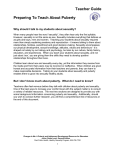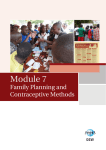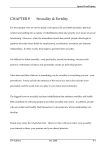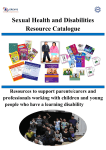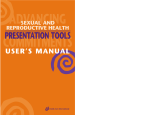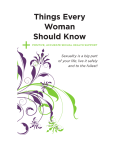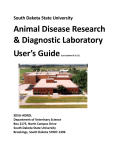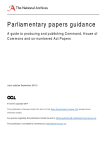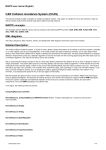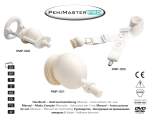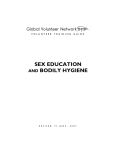Download MODULE 3
Transcript
MODULE 3 Young Adolescents’ Sexual and Reproductive Health SRH Facilitators’ Training Manual: MODULE 3 Young Adolescents’ Sexual and Reproductive Health SRH Facilitators’ Training Manual: MODULE 3 Young Adolescents’ Sexual and Reproductive Health Table of Contents Introduction Introduction1 This Module 3 of the SRH Facilitators’ Training Manual focuses on young adolescents’ sexual and reproductive health. The term “young adolescents” as used herein refers to the age group of young people between 10 and 14 years of age. Young adolescents are in an age during which they experience many physiological, social and emotional changes. Most of these changes are known as puberty. During that phase young adolescents begin to develop the ability to think more abstractly. They become less dependent on parents and more dependent on friends. At this stage, young people begin to experience sexual arousal, although boys are more focused on genitals and girls more focused on romance. While pre-adolescents begin to develop a set of best friends and start to feel peer pressures to conform, early adolescence is the peak time when peer pressure rules, and girls and boys spend more time with friends. Chapter 1: Reproductive organs, puberty and body changes 3 1.0 General introduction and/or icebreaker3 1.1 Female and male reproductive organs3 1.2 Puberty and body changes10 1.3 Menstruation and pregnancy19 1.4 Sexuality and Reproductive Health27 Chapter 2: Unhealthy relationships, harmful practices and sexual violence 37 2.1 Healthy and unhealthy relationships37 2.2 Harmful practises and sexual violence40 Chapter 3: Sexually Transmitted Infections (STIs) including HIV & AIDS 44 Annex - Tools and master copies for Module 3 47 For boys, overall maturation and initiation of puberty is about one to two years later than for girls, and therefore they are always catching up to girls biologically, cognitively and emotionally. Regardless, both groups may be unprepared for the changes they experience during puberty. While girls have the “experience” of getting their first periods and discussing this event with others, boys do not necessarily have social spaces to share similar experiences. year old boys may be asked to help support their families economically, may experience peer pressure to have first sexual experiences or may start imitating men who they know or admire and take more risks. Against the background of the amount of challenges that these young people face, early adolescence presents an opportune time to address topics related to sexual and reproductive health, share important knowledge and thus to positively influence young adolescents’ future choices and decisions. This Module contains basic but fundamental information on reproductive health, sexuality and healthy lifestyles. It is important that the facilitator prepares well and is aware of the feelings and mind sets of this young target group that this Module addresses. Every topic and issue of this Module are highly sensitive and can easily make young adolescents feeling shy, embarrassed or ashamed. It is therefore indispensable that the facilitator employs very sensitive and youth-friendly language and method especially during the facilitation of exercises. Participants may not feel comfortable in speaking openly about SRH or experiences or interacting in A ten-year old looks and acts like a child. However, by the time s/he turns 13 or 14 a huge shift has taken place. In some societies, 14year old girls are considered to be old enough for marriage, sex and childbearing while 14- © Deutsche Stiftung Weltbevoelkerung © Deutsche Stiftung Weltbevoelkerung 1 2 SRH Facilitators’ Training Manual: MODULE 3 Young Adolescents’ Sexual and Reproductive Health SRH Facilitators’ Training Manual: MODULE 3 Young Adolescents’ Sexual and Reproductive Health Chapter 1: Reproductive organs, puberty and body changes exercises with other peers, especially if they of the other sex. The facilitator shall therefore create a confident and trustworthy learning environment, be flexible and listens well to the needs and feelings of participants provide a safe space to discuss SRH and related risks and opportunities, and treat sexuality as a positive part of social development. Module 3 is divided into three chapters: Chapter 1 provides detailed information on male and female anatomy, the developments young people undergo during puberty and human sexuality. In Chapter 2 we look at the differences between healthy and unhealthy behaviour including harmful practices and sexual violence that young adolescents may encounter while growing up. Chapter 3 provides basic information on sexually transmitted infections (STIs) including HIV & AIDS . The facilitation of this module with all its exercises is expected to take about 5 hours 1.0 General introduction and/or icebreaker By the end of this module, participants will be able to: Before starting the facilitation of this Module, the facilitator may opt for an extensive general introduction where s/he explains what will be discussed and gains general trust of the participants. If the group of participants do not know each other well or seem to be very shy, the facilitator could opt for an icebreaker or energiser (see Appendix) to loosen up the atmosphere and help participants getting to know each other and feel comfortable • Describe female and male reproductive organs and functions 1.1 Female and male reproductive organs • Discuss the body changes during puberty • Understand menstruation and the situation girls are facing • Understand the concept of unhealthy relationships • Identify and understand harmful practices and know how to deal with sexual violence • Discuss their sexuality and memorize the circles of sexuality Learning objectives 1.1.1 Female reproductive organs Exercise 1: Learning more about female reproductive organs Objective: Participants to acquire in-depth knowledge of female reproductive organs Method: Large group discussions Tools: Cards, labelled charts of female reproductive organs Time: 20 minutes Facilitator’s tasks: 1. 2. 3. 4. © Deutsche Stiftung Weltbevoelkerung Ask participants to form a circle. Distribute cards or slips of paper with the correct designations of the female reproductive organs and other cards with the corresponding functions of descriptions. (See table below). Ask each participant to read the card/ paper he/she has been given. Ask for the corresponding card/paper 5. 6. 7. owned by one of the other participants to be read out loud. Ask participants to name the organ correctly and explain its functions. Encourage other participants to ask questions. Summarize the main points learnt on female reproductive organs and Ask for feedback. How did the cards activity help to explain the female reproductive organs? © Deutsche Stiftung Weltbevoelkerung 3 4 SRH Facilitators’ Training Manual: MODULE 3 Young Adolescents’ Sexual and Reproductive Health SRH Facilitators’ Training Manual: MODULE 3 Young Adolescents’ Sexual and Reproductive Health Basic information (This information could also be used as a hand-out) External female reproductive organs The vulva is the area surrounding the opening of the vagina, which can be seen from the outside. They consist of the clitoris, the vagina opening, the labia majora and the labia minora. The hymen is a membrane that surrounds or partially covers the external vaginal opening. It forms part of the vulva, or external genitalia. The size of the hymenal opening increases with age. The hymen can break from physical activity, tampons, or from sexual intercourse Internal female reproductive organs These are organs of the female body that are located inside the lower part of the abdomen, called the pelvis, and are protected by bones and muscles (see figure below). They consist of the vagina, the uterus (womb), two ovaries, and two fallopian tubes. The walls of the vagina produce a fluid or discharge that serves to keep the region clean. The amount of discharge may differ over the month and increases particularly at times of sexual excitement. Please note that this is completely normal. However, whenever its colour changes, it causes itching or takes on a bad smell, this may indicate an infection. So it is important to pay attention to the discharge and how it changes during the menstrual cycle. The uterus (womb) is a muscular organ inside a woman’s body where a baby grows during pregnancy. The cervix is sometimes also called opening/neck/mouth of the womb. It connects the uterus to the vagina and normally has a very small opening to protect the uterus from infections. During childbirth, the cervix opens as the baby has to leave the womb and enter the world through the vagina. This is why the vagina is sometimes called “birth canal” as well. The walls of the vagina are elastic and can stretch to allow the passage of the baby’s head and body. http://en.wikipedia.org/wiki/Hymen © Deutsche Stiftung Weltbevoelkerung © Deutsche Stiftung Weltbevoelkerung 5 6 SRH Facilitators’ Training Manual: MODULE 3 Young Adolescents’ Sexual and Reproductive Health SRH Facilitators’ Training Manual: MODULE 3 Young Adolescents’ Sexual and Reproductive Health 1.1.2 Male reproductive organs Male reproductive organs are those parts of the male body that are directly involved in reproduction. They consist of the external and internal parts. Exercise 2: Learning more about male reproductive organs Objective: Method: Tools: Time: Participants to acquire in-depth knowledge of male reproductive organs Large group discussions Cards, labelled charts of male reproductive organs 20 minutes Facilitators tasks: 1. 2. 3. 4. Ask participants to form a circle Distribute cards or slips of paper with the correct designations of the male reproductive organs and other cards with the corresponding functions of descriptions. (See table below) Ask each participant to read the card/ paper he/she has been given. Ask for the corresponding card/paper 5. 6. owned by one of the participants to be read out loud. Ask participants to name the organ correctly and explain its functions. Encourage other participants to ask questions. Summarize the main points learnt on male reproductive organs and Ask for feedback. How did the cards activity help to explain the male reproductive organs? Discussion: Taking care of your body and reproductive organs Adolescence is a stage where growth happens very fast. With this time, especially with the start of puberty the body is very active, involving hormones and glands that produce sweat and other body fluids that can emit smell. To have a different smell than before due to hormonal change is not unnatural, it just requires us to clean ourselves regularly. Personal hygiene and cleanliness of clothes and environment is also important to keep off diseases and infections, which are dangerous for our health. Therefore, it is advisable that the facilitator discusses with the participants ways to take good care of their body and Reproductive Health organs. © Deutsche Stiftung Weltbevoelkerung © Deutsche Stiftung Weltbevoelkerung 7 8 SRH Facilitators’ Training Manual: MODULE 3 Young Adolescents’ Sexual and Reproductive Health Facilitator’s task: • 1. Discuss with participants ways of how to take care of their reproductive health Organs in order to keep them healthy For young adolescents and youth to maintain a high degree of hygiene: • • The body should be washed at least once every day with clean water and soap. Clothes, especially underwear, should be washed regularly and dried in the sun or at dry and clean places. Basic information External male reproductive organs External male reproductive organs are those male organs that are on the outside and can be seen. They comprise the penis, the scrotum, and the testes. The penis The penis is the organ that carries the semen with the sperm into the vagina. During sexual arousal, blood is pumped into the muscles of the penis. This makes the penis stiffen/erect so it can easily enter the vagina. The penis additionally serves as the urinal duct. Although both semen and urine pass through the tube called the urethra in the penis, at the time of ejaculation the opening from the bladder is closed so that only semen comes out of the penis. After ejaculation, the blood quickly drains away into the body and the penis returns to its normal state. © Deutsche Stiftung Weltbevoelkerung • Males need to know that the penis has a foreskin (prepuce) that protects the head of the penis. Usually the penis produces a whitish creamy substance called smegma, which helps the foreskin to slide back smoothly. When smegma accumulates under the foreskin, it causes a bad smell or even infection. Therefore, boys who are not circumcised (have not had the foreskin removed) need to pull back the foreskin and gently wash underneath it with clean water every day. SRH Facilitators’ Training Manual: MODULE 3 Young Adolescents’ Sexual and Reproductive Health The scrotum The scrotum is a sac of skin containing two egg-shaped organs called the testes, found in front of and between the thighs. The scrotum protects the testes from physical damage and helps to regulate the temperature of the sperm. The testes (testicles) They are two sex glands that produce sperm and the male hormones, which are also responsible for the development of secondary sexual characteristics in men. At the onset of young adolescence stage, in boys the testes begin to produce sperm. This usually happens between the ages of 12 and 15, although it can also happen earlier or later. Internal male reproductive organs The internal male reproductive organs are situated within the lower part of the abdomen called the pelvis that is protected by bones and muscles (see figure below). They consist of the epididymis, the vas deferens, the seminal vesicles, the prostate, and the Cowper’s gland. Epididymis A cord-like structure coiled on top of the testes, it stores sperm. When sperm matures, it is allowed to pass into the vasa deferentia before being released during ejaculation. Vas deferens The vasa deferentia are tubes through which the man’s sperm passes from the testicles to the penis. When a man has a “vasectomy”, these tubes are cut and sperm can no longer pass from the testicles to the penis. This is one of only two methods of contraception (family planning) available to men. The other is use of condoms. Having a vasectomy does not prevent a man from having an erection, or from ejaculating. Seminal vesicles The seminal vesicles are like pockets or glands where the white fluid, semen, is produced. Semen is a fluid that is released through the penis when a man has an ejaculation. It provides nourishment for the sperms and helps their movement. Prostate The prostate is situated below the bladder. The prostate procedures fluid that makes up part of the semen; it helps create a good environment for the sperm in the penile urethra and vagina, enables movement of the sperm and provides nutrients for the sperm. Cowper’s gland The Cowper’s gland comprises two small glands situated below the prostate with ducts opening into the urethra. Its function is to produce some fluid, which helps create a good environment for the sperms in the penile urethra. Note: Semen is produced at three different levels, by three different organs i.e. the Cowper’s gland, the prostate and the seminal vesicles. Hormones and their functions Testosterone is the major male hormone produced mainly by the testes but also the adrenal glands. In case a man has lost his testes, these glands would continue to produce testosterone to support the male physical appearance. Testosterone is responsible for the growth and development of a boy during adolescence and for the development of sperm and secondary sexual characteristics. © Deutsche Stiftung Weltbevoelkerung 9 10 SRH Facilitators’ Training Manual: MODULE 3 Young Adolescents’ Sexual and Reproductive Health SRH Facilitators’ Training Manual: MODULE 3 Young Adolescents’ Sexual and Reproductive Health 1.2 Puberty and body changes Body changes and the development of the reproductive organs Between the ages of 10 and 14 most boys and girls begin to notice changes taking place in their bodies. These changes occur over a number of years and are generally referred to as “puberty”. Puberty is the process of physical, social, mental, emotional and behavioural changes and development that happen to young people as they move from being children to being adults who are capable of sexual reproduction and fertilisation. It is characterised by the fast growth of the body and reproductive health organs. The changes are gradual and occur at different ages and speed in different people. Puberty happens to most young people between the ages of around 9 to 18 years. Some young adolescents’ will reach this stage earlier than others. However, girls tend to reach this stage a little earlier than boys. Puberty is initiated by hormonal signals from the brain to the gonads: the ovaries in a girl, the testes in a boy. In response to these signals, the gonads produce hormones that stimulate libido and the growth, function, and transformation of the brain, bones, muscle, blood, skin, hair, breasts, and sexual organs. Physical growth - height and weight - accelerates in the first half of puberty and is completed when the child has developed an adult body. Experiencing sudden growth and change of certain body parts during the early stages of puberty can be shocking and stressful for young adolescents. It is therefore helpful for them to be know about the changes and the causes of the changes that will occur in their bodies so as to overcome the shock and stress. Exercise 3: Body mapping Objective: Participants understand the body changes during puberty Method: Large group discussions Tools: Large paper and pens, labelled charts of male and female reproductive organs Facilitator’s tasks: 1. Divide participants into groups 2. Ask each group to draw the outline of a female and male body on a big paper and put it on the ground. 3. Ask participants to mark on the body all the physical changes that happen to an adolescent person (male or female) during puberty. 4. Ask them to discuss the following questions: • What are the good things about growing up and body changes? • What are the bad things about growing up and body changes? • Why do body changes happen? • How do people feel about these changes? • What problems do we have with the changes? • What questions do we have about growing up? © Deutsche Stiftung Weltbevoelkerung 5. Ask participants to write down any other questions they may have, which you will answer later in plenary. 6. Bring all participants together and invite them to share their body maps, if they are happy to do so. Share ideas about the good and bad things about growing up, the changes and why they happen. 7. Add any additional and missing background information, using charts or pictures if available. 8. Discuss all questions that were posed and share ideas on possible answers in the group. Correct or add information as needed. If you do not know an answer to a question, say you will find out. Then find out, and answer the question at the beginning of another session. The major landmark of puberty for males is the first ejaculation, which occurs on average at age 13. For females, it is menarche, the onset of menstruation, which occurs on average between ages 12 and 13. Female body changes during puberty During puberty, the following changes occur in females’ bodies and reproductive organs. • Hips widen up in a circular shape • Increase in height and weight gain • Breasts start growing • The labia thicken, the clitoris starts to grow and reaches its final size around the age of 18 • Hair starts to grow around reproductive organs and in the armpits • The uterus increases in size • Voice starts to change • Ovaries grow and start producing ovum • The wall of the uterus becomes ready to host the foetus • Face may develop pimples • Monthly menstrual flow begins • Sexual feelings – excitement when touching our private parts Male body changes during puberty During the young adolescence stage, the following changes occur in males’ bodies and reproductive organs • Voice starts to change • Face develops pimples • Increase in height and weight gain • Shoulders and chest widen up • Hair starts to grow around reproductive organs and in the armpits, beard starts to grow • Penis and testicles start to grow • Sperm starts being produced • Sexual arousal / feelings – excitement when touching our private parts • Wet dreams can occur (see page 14) © Deutsche Stiftung Weltbevoelkerung 11 12 SRH Facilitators’ Training Manual: MODULE 3 Young Adolescents’ Sexual and Reproductive Health SRH Facilitators’ Training Manual: MODULE 3 Young Adolescents’ Sexual and Reproductive Health Hormonal changes Growth hormones cause quick growth and body change. They control how and when the body will grow, which body part will change first. Growth hormones are produced starting from the stage of young adolescence onwards. Sexual hormones are produced during puberty. They a) determines the male and female body shapes; and b) direct and controls the growth and function of reproductive organs. Under the brain’s command, hormones will be produced in the female’s ova gland (oestrogen and progesterone). They also influence behaviour. Hormones cause a quick change in body and feelings during puberty. Because of that, sometimes emotional instability is observed in young adolescents. However, as they grow older, because the production of hormone decreases, they will become more settled again. © Deutsche Stiftung Weltbevoelkerung © Deutsche Stiftung Weltbevoelkerung 13 14 SRH Facilitators’ Training Manual: MODULE 3 Young Adolescents’ Sexual and Reproductive Health SRH Facilitators’ Training Manual: MODULE 3 Young Adolescents’ Sexual and Reproductive Health Wet dreams Clarifying the myth: Wet dreams do not mean that a boy should start having sexual intercourse. It is safer to let wet dreams take care of sperm production until boys are mature enough to have a safe, caring sexual relationship. Ejaculation means that a boy is capable of making a girl pregnant. It does not mean that he is ready to become a father. When a boy reaches the age of about 12, the male sex hormone or ‘messenger’ is produced and tells the testes to start producing sperm. The sperm passes through a long tube (urethra) to the prostate, where it is mixed with a milky liquid (seminal fluid) to become semen. This is stored until it comes out through the penis in quick, short bursts: this is called ejaculation. Sometimes a boy’s first ejaculation happens at night when he is asleep. This is called a wet dream and the boy may have a dream related to sex when it happens. Some boys have regular wet dreams and others hardly ever have them. Both cases are normal. Wet dreams are the body’s way of practicing to make a baby. They are normal and not a disease. A boy should not feel shy or worried about wet dreams. They are a sign that he has reached puberty and his reproductive organs are working well. Girls can also have sexy dreams and some might find that they are wet between their legs at these times. This wetness is made in the vagina. When the girl is grown up, it will protect her vagina during sex. This is normal. © Deutsche Stiftung Weltbevoelkerung © Deutsche Stiftung Weltbevoelkerung 15 16 SRH Facilitators’ Training Manual: MODULE 3 Young Adolescents’ Sexual and Reproductive Health SRH Facilitators’ Training Manual: MODULE 3 Young Adolescents’ Sexual and Reproductive Health Developing from a child to an adult Understanding mental, emotional, social, and behavioural developments during puberty © Deutsche Stiftung Weltbevoelkerung © Deutsche Stiftung Weltbevoelkerung 17 18 SRH Facilitators’ Training Manual: MODULE 3 Young Adolescents’ Sexual and Reproductive Health SRH Facilitators’ Training Manual: MODULE 3 Young Adolescents’ Sexual and Reproductive Health 1.3 Menstruation and pregnancy The onset of the menstrual cycle (also called menarche) is one of the major landmarks of puberty among females. It begins for many girls at the age of 12. However, others might experience their first menstruation even earlier or later. It is important that young adolescents are well-informed about menstruation in order to know how to handle it and how to best react. Exercise 4: Understanding the menstrual cycle Objective: Enable participants to better understand menstruation Method: Large group work Tools: Menstrual cycle graph Time: 30 minutes Facilitator’s tasks: 1. Prepare before the beginning of the session (or ask participants to help you) separate papers/cards by photocopying or drawing with the different phases of the menstruation cycle 2. Invite volunteers to come to the m d ed il and distribute the papers/cards randomly to each of them 3. Ask them to read the text on the sheet of the paper and line up according to the menstrual cycle 4. Ask each volunteer to explain the phase of the cycle described on his/ her paper. © Deutsche Stiftung Weltbevoelkerung 5. Ask entire group the following questions • What causes menstruation? • What are the good and bad things about menstruation? • How and when can pregnancy occur during the menstruation cycle? What is conception? 6. Correct answers where necessary and provide more missing facts and information according to background knowledge 7. Summarise shortly the main points learned about: • Menstruation cycle • Conception and pregnancy • Ovulation © Deutsche Stiftung Weltbevoelkerung 19 20 SRH Facilitators’ Training Manual: MODULE 3 Young Adolescents’ Sexual and Reproductive Health Menstruation cycle graph SRH Facilitators’ Training Manual: MODULE 3 Young Adolescents’ Sexual and Reproductive Health Exercise 5: Understanding menstruation and the situation of girls Objective: Enable participants to better understand menstruation Method: Large group work Tools: Maria’s story Time: 30 minutes Facilitator’s tasks: 1. Ask the group to sit together 2. Read yourself or asks a trainee to read out Maria’s story, which is a personal experience with menstruation. Maria’s story “I was 14 when I experienced my first menstruation. I used to pull up my skirt and place a plastic sheet on my bench so that the menstrual blood does not stain my skirt. I was so stressed out about others realizing that I barely focused on my education. All I was worried about was ‘What if it stains my skirt? What if the students see it?’ The next day, our maid gave me a piece of cloth and I used it as a sanitary tissue. But as I was returning to class from the break, the cloth dropped off my underwear. I walked off pretending that was not mine but it was in vain as some students had watched it drop off my skirt. They embarrassed me asking ‘what is that smell?’ It took me a while before I got used to managing it properly. Even if I was able to manage it, the period was always stressing me out. I did not want to go to school when I was in my period. I did not want to socialize or study during those moments. My younger sister’s menstruation started even earlier than mine. She was only 13 when she first experienced menstruation. She would sit in the restroom for a very long time so that, as she told me later, it would all flow out till the last drop before she went out of there. But because I was already experienced then, I was able to help her.” Maria also said that many of her friends had gone through the same troubles and that they were sometimes ashamed of standing up from their seat. 3. Ask the following questions to the entire group and discuss the answers and comments a. Is Maria’s story realistic? b. Can someone share a similar story? c. When does menstruation start in a girl’s life, how does it begin? d. What problem does it cause? e. What are the existing cultural attitudes regarding menstruation? f. What should be done when © Deutsche Stiftung Weltbevoelkerung menstruation starts? g. What can girls do to manage their menstrual hygiene? h. How can we help each other to manage menstruation happily? i. How can boys help? How can we help girls? j. How can families, teachers, and elders help? 4. Share background knowledge, your own experiences and correct information with participants and encourage them to practice tolerance and understanding © Deutsche Stiftung Weltbevoelkerung 21 22 SRH Facilitators’ Training Manual: MODULE 3 Young Adolescents’ Sexual and Reproductive Health Basic information Menstruation and Pregnancy Menstruation is a normal, healthy part of a woman’s life. It is not an illness, dirty or shameful. All young females and women have monthly bleedings. When it happens, it means that a girl is biologically able to get pregnant. It does not mean that she is automatically mature enough to have sexual intercourse or to become a mother. The menstruation cycle Days 1-5: Menstruation (period): The lining of the womb together with an unfertilized egg leave the body in form of blood fluids and tissue lining through the vagina. The bleeding can last from 2-8 days, on average 4-6 days. The length of each period, as well as the amount of bleeding, varies from woman to woman. 1. Days 5-7: Every month, one egg grows and matures in the ovary. 2. Days 7-11: The lining of the womb starts to build up and makes its inside wall thick like a nest and ready to house a baby. (The lining continues to thicken until about day 21) 3. Days 11-14: When the egg is ready, it leaves the ovary. This moment is called ovulation. 4. Days 14-21: The egg moves through the fallopian tube into the womb. 5. Days 21-28: The egg can only survive for about 24 hours in the fallopian tube after the ovulation. Menstruation occurs when the egg is not fertilised by a sperm following sexual intercourse. If the egg reaches the womb and is not fertilized, the lining of the womb begins to dissolve. 6. Days 1-5: Menstruation: The lining of the womb together with an unfertilized egg leave the body in form of blood fluids and tissue lining through the vagina. 7. And then it starts all over again. The length of one menstrual cycle is the interval from the beginning of one monthly menstruation to the beginning of the next one. It is usually 28 days long, but it can vary between 21 and 35 days. SRH Facilitators’ Training Manual: MODULE 3 Young Adolescents’ Sexual and Reproductive Health journey through the uterus and up the fallopian tube to the egg. Of those that reach the egg, only one will be allowed to penetrate the outer layer of the egg. As the sperms approach the egg, they release enzymes that soften the outer layer of the egg. The first sperm cell that bumps into a spot that is soft enough can swim into the cell. It then merges with the nucleus of the egg and fertilization occurs. While still in the tube, the fertilized egg begins to divide and grow. At the same time, it continues to move through the tube towards the womb. It takes an average of five days to reach the inside of the womb. Within two days of reaching the womb, the fertilized egg attaches itself to the lining of the womb. This process is known as implantation. The ovum (egg) carries the hereditary characteristics of the mother and her ancestors; sperm cells carry the hereditary characteristics of the father and his ancestors. Together they contain the genetic code, a set of instructions for development. Each cell - egg or sperm - contains 23 chromosomes, and each of these chromosomes contains genes, so small that they cannot be seen through microscope. These genes are packages of chemical instructions for designing every part of a baby. They specify the sex and determine, among others, whether it will tend to be (depending also on its environment) short, tall, thin, fat, healthy, or sick. Together, they provide the blueprint for a new and unique person. The usual course of events at conception is that one egg and one sperm unite to produce one fertilized egg and one baby. But if the ovaries release two (or more) eggs during ovulation, and if both eggs are fertilized, two babies will develop. These twins will be more alike than will be siblings born from different pregnancies, because each of the latter comes from a different pregnancy, and therefore from a different fertilized egg. Twins who develop this way are referred to as fraternal twins; they may be of the same sex or of different sexes. Twins can also develop from a division of a single fertilized egg into two cells that develop separately. Because these babies share all genetic material, they will be identical twins. Conception Conception can be avoided by using contraceptives. The process of conception involves the fusion of an egg (ovum) from a woman’s ovary with a sperm from a man. Every month during a woman’s fertile years, her body gets prepared for conception and pregnancy. In one of her ovaries an egg ripens and is released from its follicle. The egg - about the size of a pinpoint, 1/250 inch in diameter – is then drawn into the fallopian tube through which it travels to the uterus. The journey takes three to four days. The lining of the uterus has already thickened to assist the implantation of a fertilized egg, or zygote. If the egg is not fertilized, it lasts 24 hours and then disintegrates. It is expelled along with the uterine lining during menstruation. Important things to note on menstruation • Menstrual blood is neither dirty nor a dangerous occurrence. The first menstrual blood takes longer to flow out and the ovary may begin producing more eggs before the occurrence of the first menstrual blood flow. Therefore, girls may become pregnant before they even begin to see their first menstruation. • A woman can get pregnant when she has sexual intercourse with a sexually mature male just before ovulation or shortly after. In an average 28-cycle, a woman can get pregnant if she has sexual intercourse on days 11-14. (However, these days are not fixed, as the length of menstrual cycles varies. It is important to use contraceptives to exclude an unwanted pregnancy and prevent an infection with HIV and AIDS or other STIs. • Menstruation continues throughout women’s reproductive life (menarche). The menstrual cycle stops between the age of 40 and 50. This is known as menopause. Sperm cells are produced in the man’s testes and ejaculated from his penis into the woman’s vagina during sexual intercourse. Sperm cells are much smaller than eggs (1/1800 inch in diameter). The typical ejaculate contains millions of sperm, but only a few complete the long © Deutsche Stiftung Weltbevoelkerung © Deutsche Stiftung Weltbevoelkerung 23 24 SRH Facilitators’ Training Manual: MODULE 3 Young Adolescents’ Sexual and Reproductive Health • • • • • After a girl has had her first menstruation, her menstrual cycle does not necessarily follow a regular pattern right from the beginning. This does normally change over time leading to a regular cycle. There are many situations that cause menstrual irregularities, for instance, diet, stressful situations, mourning, sickness, insomnia or extreme happiness etc. Menstruation is not a disease, hence a girl in her menstruation period is capable of engaging in all activities she normally engages in. Some girls may experience some discomfort during menstruation like stomach aches (as the muscles of the womb push out the blood) or headache. This is normal, not a curse or a disease. Discomfort can be eased by resting or doing some physical exercises. It is important that the girl understands that the symptoms are only temporary. However, if she does not see changes and suffers a lot, she needs to consult a Doctor. In some cultures girls’ during their menstrual periods are advised to eat some things and not other things. In others they are told not to enter sacred/ religious places during their menstruations. In yet other cultures, they are asked to stay in secluded places during their menstruation period. But all these attitudes are now changing. How can a girl keep herself clean during menstruation? In order to catch the blood from the vagina, there are different ways to do that: • Sanitary pads/towels: they are especially made for the menstruating days of women and made out of cotton wool. They are put into the under wear and catch the blood. Sanitary towels are sold in drug stores. There are two types of them, disposable ones, that have to be thrown away after one use, or re-usable ones that can be washed and used several times. Girls may also use cotton wool wrapped in thin cloth. Used sanitary pads should be disposed of in the pit latrines. • Tampon: these are tubes of cotton wool that can be inserted into the vagina to catch the blood. They can be used only one time and need to be changed regularly (latest after 8 hours, if not soaked with blood before) to avoid infections. At the end of the period, girls need to ensure that the last tampon has been removed. Exercise 6: How to make your own re-usable sanitary towel Objective: Participants make a sanitary pad from local materials Methods: Explanation, step-by-step guidance and supervision Tools: Pieces of cotton cloths, strands of cotton, needle, thread, knickers, dis posable sanitary pad. Time: 30 minutes SRH Facilitators’ Training Manual: MODULE 3 Young Adolescents’ Sexual and Reproductive Health How a girl can keep clean during menstruation There are different ways for girls to keep themselves clean during menstruation (see background information). Some girls stay away from school while menstruating if they do not have access to any sanitary towel or other hygiene products. Facilitators’ tasks: Important: Collect all needed materials and tools before the session and prepare it in advance. Step 1: • Tell the trainees they will need to listen, watch and follow step by step as you demonstrate the steps to make a re-usable sanitary towel out of local materials. • Provide each participant with 2 pieces of cotton cloths, a strand of cotton and a needle. • Demonstrate each step and provide a verbal description accordingly: 1. Fold one of the squared cloth in half and then in half again (2 folds in total) 2. Take the second cloth and fold it diagonally (corner to corner) 3. Put the folded cotton cloth inside the squared diagonal cotton cloth. 4. Then fold top corner in to meet the bottom side. 5. Fold the left and right side in to meet the top piece and place it under the top piece like an envelope. 6. Lastly sew the points together in the middle 4 times to hold it firmly and now it is ready for use. 7. Check to see if they will absorb liquids 8. Tell the trainees - After use, you should un-tie the cloth, wash it properly, dry it in the sun and iron it if possible. Repeat the steps above to use it again. Tell the trainees if they have a heavy flow then they should make the inside cloth thicker, and that they can use any cloth of any colour they like to make a sanitary towel, but that it should be cotton and no synthetic material. They can also fix a button or a ribbon to close the outer bag and be creative ! Step 2 • • Find 2 volunteers to come in the front, probably a boy and a girl. Tell them to make a sanitary towel following all the steps from the first step to the last step in order to find out whether they have understood all the steps of making a sanitary towel, if they haven’t repeat the above steps in order for them to understand. Step 3 • Provide girls with tips and information on how to take care of them during menstruation. (See background information) • Prepare and store a sanitary pad or a piece of cloth made of cotton material. © Deutsche Stiftung Weltbevoelkerung © Deutsche Stiftung Weltbevoelkerung 25 26 SRH Facilitators’ Training Manual: MODULE 3 Young Adolescents’ Sexual and Reproductive Health • • • • • • • • Keep the sanitary pad or the piece of cotton cloth in your bag when going to school or other places. Change the sanitary pad/piece of cloth as soon as it gets wet. Otherwise, it may develop germs or leak. If it is a re-usable sanitary towel, then it has to be washed and dried up under the sun. Wash/bath more often during menstruation period. Washing only the outer side and edge of the sexual organ/vagina is enough. It is advisable to wash downwards from the sexual organ/vagina to the anus. If you wash from the anus towards the sexual organ/vagina, then harmful bacteria and germs coming out of the anus might go into the sexual organ/vagina and cause infection. Use minimal soap and be careful to avoid getting soap inside the vagina because soap tends to dry-out the mucus membrane of the inside of the vulva which may cause irritation, and toxins that may be present in some soaps that are easily absorbed through the mucus membrane. Also soaps affect the natural pH balance of the vagina - this can lead to bad smell and increase the risk of infections. Even if a girl has a regular menstruation, this does not mean that the girl should start having sex. It is important that girls stay away from sex during young adolescence as their sexual organs are yet not strong enough to bear sex and, therefore, might be damaged. It is also advisable/possible to discuss menstruation with parents. Conclude the session by informing the participants that they can discuss menstruation related issues with their parents, peers, sisters, and friends. Ask male participants if they have learned something new and would like to express their commitment to help girls/ women during their menstruation period. SRH Facilitators’ Training Manual: MODULE 3 Young Adolescents’ Sexual and Reproductive Health 1.4 Sexuality and Reproductive Health Exercise 7: What is sexuality? Objective: Participants understand that we are have our sexuality from the time we are born up to when we die and that we do not only need sexual intercourse to enjoy our sexuality. Methods: Group work Tools: Flip chart and markers Time: 30 minutes Step 1: Divide participants in six small groups and give each group one of the following to discus • A baby boy and a baby girl • A baby boy and girl aged 6 years • A baby boy and girl aged 15 years • A married man and woman aged 22 years • A woman and man with a baby • An Elderly man and woman Ask every group to discuss how the person they have been given might feel and express his or her sexuality. For example a 6 year old boy or girl plays mummy and daddy roles. Step 2: Ask the group to tell the plenary their ideas about sexuality in the age group they talked about. Other groups may add their ideas. Step 3: Ask the participants what they have learnt from this activity. Step 4: Point out that we can enjoy our sexuality at all ages even without having sexual intercourse. We should be in a hurry to have sexual intercourse, but wait until our minds and bodies are mature. We should trust ourselves that when the time comes, we shall do it well. 1.4.1. Sex and sexuality During puberty the need for being in a relationship, feelings of love and readiness for sexual involvement with the opposite sex become stronger. As a result, boys begin to have wet and erotic dreams accompanied by night-time semen emission. Likewise, girls can also have wet dreams and experience lubrication of the vagina resulting into an internal urge to satisfy the dissatisfied sexual need. In addition to that, there is sometimes peer group influence, erotic movies and music, pushing towards sexual activity. Young adolescents therefore, need knowledge on SRH and life skills (see Module 2) to cope with the changes that occur at this stage. Young adolescents’ may experience sexual feelings and this is a natural feeling. These feelings however may provoke many questions about sex: “What is sex? How would I feel if I had sex? What is love? Will I find someone I love and who loves me? © Deutsche Stiftung Weltbevoelkerung © Deutsche Stiftung Weltbevoelkerung 27 28 SRH Facilitators’ Training Manual: MODULE 3 Young Adolescents’ Sexual and Reproductive Health What is sex? SRH Facilitators’ Training Manual: MODULE 3 Young Adolescents’ Sexual and Reproductive Health An Explanation of the Circles of Sexuality Sex refers to whether or not a person is male or female, whether a person has a penis or a vagina. Many of you may have noticed on different forms you have completed for school or at the doctor’s office that there is often a question on the form called “Sex.” You are required to check either male or female. Sex is also commonly used as an abbreviation to refer to sexual intercourse. What is sexuality? Sexuality may be defined as the way • • • People think and the attitudes they hold about others, The way they relate with each other and the opposite sex, The way they behave, as a result of being females or males. Sexuality begins at birth and stops at death. However, it differs with age and social exposure. Sexuality refers to the total expression of who you are as a human being, your femaleness or your maleness. Everyone is a sexual being. Your sexuality is interplay between body image, gender identity, gender role, sexual orientation, eroticism, genitals, intimacy, relationships, and love and affection. A person’s sexuality includes his or her attitudes, values, knowledge and behaviours. How people express their sexuality is influenced by their families, culture, society, faith and beliefs. A very narrow view of sexuality has been limited to sexual relationships and reproduction among people. It is important to re-examine this concept in the light of working with adolescents or any group of children at any stage of development. Sexuality is not synonymous with sex; rather it is part of a person’s entire life from birth to death. It does not only entail genital and reproductive processes but encompasses gender roles, social roles, self-esteem, feelings and relationships. Sexuality is how one feels about him/herself as being a male or female, how one consequently relates to members of the same and opposite sex, and how one feels about her/himself as a totals person. The Circles of Sexuality Source: http://www.advocatesforyouth.org/lessonplans/circlesofsexuality3.htm NOTE TO THE FACILITATOR: When explaining the circles of sexuality, consider the cultural context of your group as this section contains very sensitive aspects. © Deutsche Stiftung Weltbevoelkerung Sexuality is much more than sexual feelings or sexual intercourse. It is an important part of who a person is and what she/he will become. It includes all the feelings, thoughts, and behaviours associated with being female or male, being attractive and being in love, as well as being in relationships that include sexual intimacy and sensual and sexual activity. It also includes enjoyment of the world as we know it through the five senses: taste, touch, smell, hearing, and sight. © Deutsche Stiftung Weltbevoelkerung 29 30 SRH Facilitators’ Training Manual: MODULE 3 Young Adolescents’ Sexual and Reproductive Health 1.4.2 Factors leading to young adolescents engaging in sex • Lack of knowledge on the possible consequences of sexual activity • Sexual abuse: rape, incest • Poverty • Lack of life skills: assertiveness, self-awareness, negotiation skills, self-esteem and decision-making. • Alcohol and substance abuse • Peer pressure • Environmental social setting: poor housing, slums • Influence of media • Insecurity Possible consequences of young adolescents’ engaging in sex • Early or unwanted pregnancy • STI’s/HIV & AIDS • Emotional consequences: shame, guilt, fear • Social consequences: dropping out of school, stigmatisation, forced marriage, stunted growth for the young adolescent, low social status 1.4.3 How to protect oneself from an unwanted pregnancy? There are various ways to protect oneself from unwanted pregnancies. Modern contraceptives offer a high level of protection. For young adolescents it may be too early to know them in detail. However, it might be useful for those between 12 and 14 to see a condom and to know how it is used correctly once before they are sexually active. SRH Facilitators’ Training Manual: MODULE 3 Young Adolescents’ Sexual and Reproductive Health Basic Information Detailed explanation of the “Circles of Sexuality” Circle #1—Sensuality Sensuality is awareness and feeling about your own body and other people’s bodies, especially the body of a sexual partner. Sensuality enables us to feel good about how our bodies look and feel and what they can do. Sensuality also allows us to enjoy the pleasure our bodies can give us and others. This part of our sexuality affects our behaviour in several ways. Body image: Feeling attractive and proud of one’s own body and the way it functions influences many aspects of life. Adolescents often choose media personalities as the standard for how they should look, so they are often disappointed by what they see in the mirror. They may be especially dissatisfied when the mainstream media does not portray or does not positively portray physical characteristics the teens see in the mirror, such as colour of skin, type or hair, shape of eyes, height, or body shape. Experiencing pleasure: Sensuality allows a person to experience pleasure when certain parts of the body are touched. People also experience sensual pleasure from taste, touch, sight, hearing, and smell as part of being alive. Satisfying skin hunger: The need to be touched and held by others in loving, caring ways is often referred to as skin hunger. Adolescents typically receive considerably less touch from their parents than do younger children. Many teens satisfy their skin hunger through close physical contact with peers. Sexual intercourse may sometimes result from a teen’s need to be held, rather than from sexual desire. Objective: Participants know how to use a condom Method: Condom demonstration Tools: Condoms, wooden penis Time: 20 minutes Feeling physical attraction for another person: The centre of sensuality and attraction to others is not in the genitals (despite all the jokes). The centre of sensuality and attraction to others is in the brain, humans’ most important “sex organ.” The unexplained mechanism responsible for sexual attraction rests in the brain, not in the genitalia. Fantasy: The brain also gives people the capacity to have fantasies about sexual behaviours and experiences. Adolescents often need help understanding that sexual fantasy is normal and that one does not have to act upon sexual fantasies. Facilitator’s task: Circle #2: Sexual Intimacy 1. Demonstrate to participants how a condom looks like and how it is used. ( Refer to Module 7 pages 5-9) Sexual intimacy is the ability to be emotionally close to another human being and to accept closeness in return. Several aspects of intimacy include Exercise 7: How to use a condom Sharing: Sharing intimacy is what makes personal relationships rich. While sensuality is about physical closeness, intimacy focuses on emotional closeness. Caring: Caring about others means feeling their joy and their pain. It means being open to emotions that may not be comfortable or convenient. Nevertheless, an intimate relationship is possible only when we care. © Deutsche Stiftung Weltbevoelkerung © Deutsche Stiftung Weltbevoelkerung 31 32 SRH Facilitators’ Training Manual: MODULE 3 Young Adolescents’ Sexual and Reproductive Health Liking or loving another person: Having emotional attachment or connection to others is a manifestation of intimacy.Emotional risk-taking: To have true intimacy with others, a person must open up and share feelings and personal information. Sharing personal thoughts and feelings with someone else is risky, because the other person may not feel the same way. But it is not possible to be really close with another person without being honest and open with her/him. SRH Facilitators’ Training Manual: MODULE 3 Young Adolescents’ Sexual and Reproductive Health Negative social messages and homophobia in the wider culture can mean that young adolescents who are experiencing sexual attraction to and romantic feelings for someone of their own gender need support so they can clarify their feelings and accept their sexuality. Circle #4: Reproduction and Sexual Health Vulnerability: To have intimacy means that we share and care, like or love, and take emotional risks. That makes us vulnerable: the person with whom we share, about whom we care, and whom we like or love, has the power to hurt us emotionally. Intimacy requires vulnerability, on the part of each person in the relationship. Circle #3: Sexual Identity Sexual identity is a person’s understanding of who she/he is sexually, including the sense of being male or of being female. Sexual identity consists of three “interlocking pieces” that, together, affect how each person sees him/herself. Each “piece” is important. Gender identity: Knowing whether one is male or female. Most young children determine their own gender identity by age two. Sometime, a person’s biological gender is not the same as his/her gender identity: this is called being transgender. Gender role: Identifying actions and/or behaviours for each gender. Some things are determined by the way male and female bodies are built or function. For example, only women menstruate and only men produce sperm. Other gender roles are culturally determined. There are many “rules” about what men and women can/should do that have nothing to do with the way their bodies are built or function. This aspect of sexuality is especially important for young adolescents to understand, since peer, parent, and cultural pressures to be “masculine” or “feminine” increase during the adolescent years. Both young men and young women need help sorting out how perceptions about gender roles affect whether they feel encouraged or discouraged in their choices about relationships, leisure activities, education, and career. Gender bias means holding stereotyped opinions about people according to their gender. Gender bias might include believing that women are less intelligent or less capable than men, that men suffer from “testosterone poisoning,” that men cannot raise children without the help of women, that women cannot be analytical, that men cannot be sensitive. Many times, people hold fast to these stereotyped opinions without giving rational thought to the subject of gender. Sexual orientation: Whether a person’s primary attraction is to people of the other gender (heterosexuality) or to the same gender (homosexuality) or to both genders (bisexuality) defines his/her sexual orientation. Sexual orientation begins to emerge by adolescence although many gay and lesbian youth say they knew they felt same sex attraction by age 10 or 11. Between three and 10: percent of the general population is probably exclusively homosexual in orientation. Perhaps another 10 percent of the general population feel attracted to both genders. Heterosexual, gay, lesbian, and bisexual youth can all experience same-gender sexual attraction and/or activity around puberty. Such behaviour, including sexual play with same-gender peers, crushes on same-gender adults, or sexual fantasies about same-gender people are normal for pre- teens and young teens and are not necessarily related to sexual orientation. © Deutsche Stiftung Weltbevoelkerung These are a person’s capacity to reproduce and the behaviours and attitudes that make sexual relationships healthy and enjoyable. Factual information about reproduction: Is necessary so youth will understand how male and female reproductive systems function and how conception and/or STD infection occur. Adolescents often have inadequate information about their own and/or their partner’s body. Teens need this information so they can make informed decisions about sexual expression and protect their health. Youth need to understand anatomy and physiology because every adolescent needs the knowledge and understanding to help him/her appreciate the ways in which his/her body functions. Feelings and attitudes: Are wide-ranging when it comes to sexual expression and reproduction and to sexual health-related topics such as STD infection, HIV and AIDS, contraceptive use, abortion, pregnancy, and childbirth. Sexual intercourse: Is one of the most common behaviours among humans. Sexual intercourse is a behaviour that may produce sexual pleasure that often culminates in orgasm in females and in males. Sexual intercourse may also result in pregnancy and/or STDs. In programs for youth, discussion of sexual intercourse is often limited to the bare mention of male-female (penilevaginal) intercourse. However, youth need accurate health information about sexual intercourse: vaginal, oral, and anal. Reproductive and sexual anatomy: The male and female body and the ways in which they actually function is a part of sexual health. Youth can learn to protect their reproductive and sexual health. This means that teens need information about all the effective methods of contraception currently available, how they work, where to obtain them, their effectiveness, and their side effects. This means that youth also need to know how to use latex condoms to prevent STD infection. Even if youth are not currently engaging in sexual intercourse, they probably will do so at some point in the future. They must know how to prevent pregnancy and/or disease. Finally, youth also need to know that traditional methods of preventing pregnancy (that may be common in that particular community and/or culture) may be ineffective in preventing pregnancy and may, depending on the method, even increase susceptibility to STDs. The leader will need to determine what those traditional methods are, their effectiveness, and their side effects before he/she can discuss traditional methods of contraception in a culturally appropriate and informative way. Sexual reproduction: The actual processes of conception, pregnancy, delivery, and recovery following childbirth are important parts of sexuality. Youth need information about sexual reproduction: the process whereby two different individuals each contribute half of the genetic material to their child. The child is, therefore, not identical to either parent. [Asexual reproduction is a process whereby simple one-celled organisms reproduce by splitting, creating © Deutsche Stiftung Weltbevoelkerung 33 34 SRH Facilitators’ Training Manual: MODULE 3 Young Adolescents’ Sexual and Reproductive Health two separate one-celled organisms identical to the original [female] organism before it split.] Too many programs focus exclusively on sexual reproduction when providing sexuality education and ignore all the other aspects of human sexuality. Circle #5: Sexualisation Sexualisation is that aspect of sexuality in which people behave sexually to influence, manipulate, or control other people. Often called the “shadowy” side of human sexuality, sexualisation spans behaviours that range from the relatively harmless to the sadistically violent, cruel, and criminal. These sexual behaviours include flirting, seduction, withholding sex from an intimate partner to punish her/him or to get something, sexual harassment, sexual abuse, and rape. Teens need to know that no one has the right to exploit them sexually and that they do not have the right to exploit anyone else sexually. Flirting: Is a relatively harmless sexualisation behaviour. Nevertheless, upon occasion it is an attempt to manipulate someone else, and it can cause the person manipulated to feel hurt, humiliation, and shame. Seduction: Is the act of enticing someone to engage in sexual activity. The act of seduction implies manipulation that at times may prove harmful for the one who is seduced. Sexual harassment: Is an illegal behaviour. Sexual harassment means harassing someone else because of her/his gender. It could mean making personal, embarrassing remarks about someone’s appearance, especially characteristics associated with sexual maturity, such as the size of a woman’s breasts or of a man’s testicles and penis. It could mean unwanted touching, such as hugging a subordinate or patting someone’s bottom. It could mean demands by a teacher, supervisor, or other person in authority for sexual intercourse in exchange for grades, promotion, hiring, raises, etc. All these behaviours are manipulative. The laws provide protection against sexual harassment. Youth should know that they the right to file a complaint with appropriate authorities if they are sexually harassed and that others may complain of their behaviour if they sexually harass someone else. Rape: Means coercing or forcing someone else to have genital contact with another. Sexual assault can include forced petting as well as forced sexual intercourse. Force, in the case of rape, can include use of overpowering strength, threats, and/or implied threats that arouse fear in the person raped. Youth need to know that rape is always illegal and always cruel. Youth should know that they are legally entitled to the protection of the criminal justice system if they are the victims of rape and that they may be prosecuted if they force anyone else to have genital contact with them for any reason. Refusing to accept no and forcing the other person to have sexual intercourse always means rape. © Deutsche Stiftung Weltbevoelkerung SRH Facilitators’ Training Manual: MODULE 3 Young Adolescents’ Sexual and Reproductive Health Incest: Means forcing sexual contact on any minor who is related to the perpetrator by birth or marriage. Incest is always illegal and is extremely cruel because it betrays the trust that children and youth give to their families. Moreover, because the older person knows that incest is illegal and tries to hide the crime, he/she often blames the child/youth. The triple burden of forced sexual contact, betrayed trust, and self-blame makes incest particularly damaging to survivors of incest. Source: Adapted from Life Planning Education, a comprehensive sex education curriculum. Washington, DC: Advocates for Youth, 2007. Unwanted pregnancy Unwanted pregnancy is a pregnancy that occurs when it is not wanted, mostly by the woman or her partner or both. There are various factors determining whether a couple wants to have a child at a certain point, including the age of partners, influence of the family and the community, financial constraints and a person’s plan for life. An unwanted pregnancy is different from an unplanned pregnancy: pregnancy can be unplanned, or unexpected, and the woman or her partner are very happy about it. And of course a pregnancy can also be both unplanned and unwanted. Lastly, an unwanted pregnancy is different from an early pregnancy, a pregnancy which takes place in a young girl whose body is not mature enough to handle it well, and who is also not emotionally ready to be a mother. An early pregnancy can be wanted or unwanted, planned or unplanned – but it is always a danger to the girl and her baby. Causes of unwanted pregnancy The following are possible factors leading to unwanted pregnancy: • Early marriage • Peer pressure • Sexual experimentation • Unavailability of contraceptives • Misinformation or myths on male/female sexuality • Fear or myths about contraceptive use • Not using contraceptives • Lack of knowledge or information • Wish to express love • Failure to use contraceptive methods properly • Sexual abuse or sexual violence, such as rape and defilement • Lack of ability to negotiate contraceptive use or safer sex • Poverty Early/Teenage pregnancy Teenage pregnancy refers to pregnancy in a female under the age of 20 (when the pregnancy ends). A pregnancy can take place at any time before or after puberty, with menarche (first menstrual period) normally taking place around the ages 12 or 13, and being the stage at which a female becomes potentially fertile. Note: A young girl can become pregnant if she has unprotected sexual intercourse around the time of her first ovulation before her ever first menstrual flow. © Deutsche Stiftung Weltbevoelkerung 35 36 SRH Facilitators’ Training Manual: MODULE 3 Young Adolescents’ Sexual and Reproductive Health SRH Facilitators’ Training Manual: MODULE 3 Young Adolescents’ Sexual and Reproductive Health Chapter 2: Unhealthy relationships, harmful practices and sexual violence Medical risks The risk of having serious complications during pregnancy or childbirth is much higher for girls in their early teens than for older women. Ages of 20–30 years are the safest period of women’s life for child bearing. The major difference between girls in their early teens and older women is that girls aged 12–16 years are still growing. The pelvis or bony birth canal of a girl can grow wider by as much as 20% between the time she begins menstruating and the time she is 16 years old. This widening of the pelvis can make the crucial difference between a safe delivery and obstructed labour. It is not surprising, therefore, to find that obstructed labour due to disproportion between the size of the infant’s head and the mother’s pelvis is most common among very young mothers. Obstructed/Prolonged labour: Labour is said to be obstructed when there is absence of progress in the presence of strong uterine contractions. The baby cannot pass through the pelvis because the pelvis is too small. Before the girl reaches 16 years, her pelvis is not fully developed and is therefore narrow. Obstructed labour might make a Caesarean section necessary. This is a surgical operation carried out to remove the baby from the uterus. If the operation is not done in time, the baby may die inside the uterus and the mother become very ill or even die. Prolonged labour may take up to 7 days. The uterus may tear (rupture) and the mother dies of blood loss. The head of the baby may tear the vagina, resulting in obstetric fistula. Obstetric fistula: Obstetric fistula is an injury of childbearing that is usually caused by several days of obstructed labour, without timely medical intervention. Unattended obstructed labour can last for up to six or seven days, although the foetus usually dies after two or three days. During the prolonged labour, the soft tissues of the pelvis are compressed between the descending baby’s head and the mother’s pelvic bone. The lack of blood flow causes tissue to die, creating a hole between the mother’s vagina and bladder (known as a vesico-vaginal fistula), or between the vagina and rectum (causing a recto-vaginal fistula) or both. The result is a leaking of urine or faeces or both. The consequences of fistula are often life shattering: In about 95 % of cases, the baby dies. The woman is left with chronic incontinence. Because of her inability to control her flow of urine or faeces, she is often abandoned or neglected by her husband and family and ostracized by her community. Without treatment, her prospects for work and family life are greatly diminished, and she is often left to rely on charity. Fistula is treatable as well as preventable. Reconstructive surgery can mend the injury, and success rates are as high as 90 % for uncomplicated cases (For complicated cases, the success rate is closer to 60%). Two weeks or more of post-operative care is needed to ensure a successful outcome. Other health complications: Very young women who become pregnant face a higher risk than older women in developing a number of other complications such as • Excessive vomiting • Severe anaemia • Hypertension • Convulsions • Difficulty in breast feeding (if the girl is too young to produce milk) • Infection • Higher maternal and infant mortality Early birth: The baby may be born too early before it is fully developed or have a low birth weight. © Deutsche Stiftung Weltbevoelkerung 2.1 Healthy and unhealthy relationships Exercise 8: Healthy and unhealthy relationships Objective: Sensitize participants for healthy and unhealthy relationships Method: Open discussion Tools: Cards, 2 large sheets of paper or flip charts, markers, pins Time: 20 minutes Facilitator’s tasks: 1. Write down different characteristics of healthy and unhealthy relationships 2. Write on two large papers/flip charts “healthy relationship” and “unhealthy relationship” 3. Distribute cards to the group and ask participants to pin their cards to the paper/flip chart they think it belongs to. 4. Discuss the results in the group, ex change experiences (if adequate) and identify ways of how to avoid unhealthy relationships. What makes a healthy relationship? Good relationships are based on love, respect and willingness to put effort into the relationship. In a good relationship, partners are honest with each other. Both individuals feel safe in the relationship and do not worry that the other one will betray his or her trust. Both partners usually find enjoyment and pleasure in the relationship, and neither tries to control or push the other into doing things. Neither person exploits or uses the other in any way. There are several qualities that make a relationship special. The best relationships are between partners who contribute all of the following qualities: Respect -To respect others means to honour them, to hold them in high esteem, to treat them as valuable even when they are different from you. Responsibility-To be responsible means that others can depend on you, that you will do as you said you would, and will be able to distinguish right from wrong. For example, you take care of your own health and well-being and that of your partner or your young brother, too. Understanding -To be understanding means to be knowledgeable about another person, and to try to understand him or her feelings and position. It means trying to ‘put yourself in someone else’s shoes’ in order to understand what life looks like from their point of view. © Deutsche Stiftung Weltbevoelkerung 37 38 SRH Facilitators’ Training Manual: MODULE 3 Young Adolescents’ Sexual and Reproductive Health Work -To work on a relationship means to put effort into the relationship, and not take the other person for granted. Caring -To be caring means to be concerned and interested in others’ feelings and needs, and to want for them what is best for them. It also means feeling love or a liking for a person and wanting to protect that person. Mutual respect - Mutual respect in a relationship means that each person values the other and knows - and would never challenge - the other person’s boundaries. Trust - You are talking with another person, and your boyfriend walks by. Does he completely lose his cool or just keep walking because he knows you would never cheat on him? It is normal to get a little jealous sometimes - jealousy is a natural emotion. But how a person reacts when he or she feels jealous is what matters. There’s no way you can have a healthy relationship if you do not trust each other. Honesty - This one goes hand-in-hand with trust because it is tough to trust someone when one of you is not being honest. Have you ever caught your girlfriend in a major lie? Like she told you that she had to work on Friday night but it turned out she was somewhere else with her friends? The next time she says she has to work, you will have a lot more trouble believing her and the trust will be on shaky ground. Support - It is not just in bad times that your partner should support you. Some people are great when your whole world is falling apart but ca not take being there when things are going right (and vice versa). In a healthy relationship, your significant other is there with a shoulder to cry on when you find out about a problem and to celebrate with you when you are happy. Fairness/equality - You need to have give-and-take in your relationship, too. Do you take turns choosing which new movie to see? As friends, do you go out with your partner’s friends as often as you go out with yours? It is not like you have to keep a running count and make sure things are exactly even, of course. But you will know if it is not a pretty fair balance. Things get bad really fast when a relationship turns into a power struggle, with one person fighting to get his or her way all the time. Separate identities - In a healthy relationship, everyone needs to make compromises. But that does not mean you should feel like you are losing out on being yourself. When you started going out, you both had your own lives - your own families, friends, interests, hobbies, etc. - and that should not change. Neither of you should have to pretend to like something you do not, or give up seeing your friends, nor drop out of activities you love. And you also should feel free to keep developing new talents or interests, making new friends, and moving forward. SRH Facilitators’ Training Manual: MODULE 3 Young Adolescents’ Sexual and Reproductive Health miscommunication is avoided in the first place. Never keep a feeling bottled up because you are afraid it is not what your boyfriend or girlfriend wants to hear or because you worry about sounding silly. And if you need some time to think something through before you are ready to talk about it, the right person will give you some space to do that if you ask for it. What makes an unhealthy relationship? A relationship is unhealthy when it involves mean, disrespectful, controlling, or abusive behaviour. Some people live in homes with parents who fight a lot or abuse each other emotionally or physically. For some people who have grown up around this kind of behaviour it can almost seem normal or okay. It is not! Many of us learn from watching and imitating the people close to us. So someone who has lived around violent or disrespectful behaviour may not have learned how to treat others with kindness and respect or how to expect the same treatment. Even though you may feel bad or feel attached to someone who’s been mistreated, you need to take care of yourself - it is not healthy to stay in a relationship that involves abusive behaviour of any kind. What are signs of an unhealthy relationship? Ask yourself, does my boyfriend or girlfriend: • Get angry when I don’t drop everything for him or her? • Criticize the way I look or dress, and say I will never be able to find anyone else who would date me? • Keep me from seeing friends or from talking to any other guys or girls? • Want me to quit an activity, even though I love it? • Ever raise a hand when angry, like he or she is about to hit me? • Try to force me to go further sexually than I want to? These aren’t the only questions you can ask yourself. If you can think of any way in which your boyfriend or girlfriend is trying to control you, makes you feel bad about yourself, isolates you from the rest of your world, or - this is a big one - harms you physically or sexually, then it is time to get out, fast. Let a trusted friend or family member know what is going on and make sure you are safe. It can be tempting to make excuses or misinterpret violence as an expression of love. But even if you know that the person hurting you loves you, it is not healthy. No one deserves to be hit, shoved, or forced into anything he or she doesn’t want to do. Good communication – You have probably heard lots of things about how men and women do not seem to speak the same language. We all know how many different meanings the little phrase “no, nothing is wrong” can have, depending on who is saying it. But what is important is to ask if you are not sure what he or she means, and speak honestly and openly so that the © Deutsche Stiftung Weltbevoelkerung © Deutsche Stiftung Weltbevoelkerung 39 40 SRH Facilitators’ Training Manual: MODULE 3 Young Adolescents’ Sexual and Reproductive Health SRH Facilitators’ Training Manual: MODULE 3 Young Adolescents’ Sexual and Reproductive Health 2.2 Harmful practices and sexual violence use whatever options they have to prevent any type of physical or emotional violence. b) Highlight that sexual abuse and harmful practices increase the risk of getting infected with sexually transmitted infections, such as HIV. c) Point out that every country has laws that shall protect Many young adolescent girls and boys are affected by harmful practices and/or (sexual) violence. Some girls are forced into early marriage, and others are exposed to harmful practices like female genital mutilation (FGM). As a result they are hurt physically and psychologically. Exercise 9: Dealing with (sexual) violence Objective: To show young adolescent girls and boys ways to deal with violence Method: Story telling and experience sharing Tools: Discussion in pairs, using provoking questions Time: 35 minutes Facilitator’s tasks Do people in your area practice female genital mutilation? How? 1. Prepare in advance for this session and • Which type of violence is a threat to you get informed about relevant national personally? laws. 5. Provide information on how to handle 2. Introduce the activity. violence 3. Post discussion questions/points on the a) Demonstrate skills (Please see wall so that the participants share their Module 2 for applicable life own experiences. skills) that help participants 4. Read out each question and ask prevent violence when they feel if there is anyone who has related threatened. experience. (if necessary, pair b) Ask participants to role-play the participants up and let them discuss taking different roles as the following questions). a boy trying to attack a girl and • Do you know any adolescent who has the girl crying out for help and been naively persuaded into having escaping from his grip…(it’s sex? Have you heard such story? Ask important to demonstrate that participant who has heard such a story violators often fear light and a to share with the other participants shouting victim) • Do you know adolescents who were c) Ask all participants to rise from exposed to rape attempts? Have you their seats and shout out to get heard such a story? Ask participant rid of their fear and shyness to who has heard such a story to share be able to cry out loud when with the other participants. under threat. • Do you know anyone who was married d) Ask participants how much off at early age? Have you heard such the shouting out helps in story in your community, among preventing impending threat of your relatives or neighbours? Ask any violence. participant who has heard such a story 6. Summarise the most important issues: to share with the other participants a) Encourage individuals to get over their fear and shyness and © Deutsche Stiftung Weltbevoelkerung • individuals from harmful practices or violence. d) Explain that there are places where young adolescents can find help in case of violence and encourage them to not be ashamed to talk about incidences of violence and to seek professional help. Basic information Harmful practises Traditional practices In different societies there are several traditional practices involving young people as they grow up. Some practices are detrimental to human health and wellbeing while others are not. In some societies, use of herbs, pulling and cutting of parts of sexual organs are practiced. The use of herbs as such and other practices that do not involve physical injury are comparably harmless and may not pose a medical risk. However, in various societies and parts of the world, there are certain traditional practices which pose a health risk, of which some have been stopped while others are still going on. Male circumcision This is a practice where the outer covering at the tip of the penis, the prepuce covering the glans, is cut. In many societies, circumcision is done as a tradition, but also in the modern world circumcision is largely practiced for hygiene related and medical reasons. Whether male circumcision reduces the chances of acquiring STDs including HIV during sexual intercourse is controversial. Male circumcision, if carried out professionally and performed under sterile conditions, is a minor surgery whose impacts are far from being equal to those of the traditional practise of female circumcision. Female genital mutilation/cutting/ circumcision This is a practice where part of or the whole clitoris is cut from the vagina. In some societies, the vaginal opening is sewn and a small opening is left, in addition to the clitoris cutting. Female Genital Mutilation (FGM) is a bad practice, because it denatures the physical parts of the genitalia. It causes pain to the victim especially during the process, when having sex and giving birth. It endangers the health of an individual because during and after the process and in the life time it can ease the infections. FGM is discouraged by international laws. Societies which still practice it should be sensitized to stop it. According to the World Health Organization (WHO), female genital mutilation (FGM) includes procedures that intentionally alter or cause injury to the female genital organs for non-medical reasons. The procedure has no health benefits for girls and women. Procedures can cause severe bleeding and problems urinating, and later cysts, © Deutsche Stiftung Weltbevoelkerung 41 42 SRH Facilitators’ Training Manual: MODULE 3 Young Adolescents’ Sexual and Reproductive Health infections, infertility as well as complications in childbirth increased risk of newborn deaths. Long-term consequences can include: recurrent bladder and urinary tract infections; cysts; infertility; an increased risk of childbirth complications and newborn deaths; the need for later surgeries. For example, the FGM procedure that seals or narrows a vaginal opening needs to be cut open later to allow for sexual intercourse and childbirth. Sometimes it is stitched again several times, including after childbirth, hence the woman goes through repeated opening and closing procedures, further increasing and repeated both immediate and long-term risks. Early Marriage Despite national and international laws relating to minimum ages of marriage, marriage of girls below these legal limits (generally set at around 18 years of age for girls – the age is usually higher for boys) is still common in many countries, particularly in rural areas, and among poor or poorly educated communities. The greatest risks associated with early marriage are that the girl will be forced to leave school and end her education, and that an early marriage also means early pregnancy. Early pregnancies, as we have seen in previous sessions, carry risks for both the young mothers and their children. Children born to adolescent mothers are more likely to die during their first year of life than those born to women in their twenties, and are at even greater risk during their second year. Wife (widow) inheritance This practice is most common in cultures where men pay a “bride-price” for their wives. If the man dies, several factors converge. Women are more likely to be seen as possessions, something which has been “purchased” by the man and his family and therefore another (male) family member simply “inherits” the wife, just as he might a house or cattle. The second is that in cultures where a woman, once married, may not return to her father’s home, there is little choice for the woman (and her children) but to accept whatever security (social, financial) is offered by remaining within her husband’s family. The practice not only devalues women, but is now to contribute widely to the spread of STIs, including HIV/AIDS. Sexual Violence There are several forms of sexual violence. Three of the most common ones are described below. Sexual abuse Sexual abuse is defined as “Violation perpetrated by a person who holds, or is perceived to hold, power over someone who is vulnerable” (Shanler 1998:1). The abuse may have physical, verbal and emotional components. It includes such sexual violations as rape, sexual assault, sexual harassment, incest, and sexual molestation. Sexual harassment Sexual pressuring of someone in a vulnerable or dependent position - a youth, employee, or student for example - is termed as sexual harassment. Employers, teachers, or other people in © Deutsche Stiftung Weltbevoelkerung SRH Facilitators’ Training Manual: MODULE 3 Young Adolescents’ Sexual and Reproductive Health authority may use their ability to control or influence jobs or grades to coerce people into sexual relations or punish them if they refuse. In extreme cases, a person may be threatened with being fired or being given bad grades if she or he will not submit to the demand. Sexual harassment can take a variety of forms, including verbal sexual remarks about clothing or appearance, unnecessary touching or pinching, and demands for sexual favours. Sexual assault: Rape Sexual coercion that relies on the threat or use of physical force or takes advantage of circumstances that render a person incapable of giving consent to sexual intercourse (such as when drunk) constitute sexual assault or rape. When the victim is younger than a legally defined “age of consent,” the age at which a young person is said to be capable of fully understanding and consenting /agreeing to sexual intercourse. Many countries set 16 as the legal age of consent. The act constitutes statutory rape (often referred to as “defilement”), whether or not coercion is involved. Rape victims suffer both physical and psychological injury. For most, physical wounds are not severe and heal within a few weeks. Psychological pain lasts longer and is often considered to be worse than the physical suffering. Often young adolescents are abused by someone they know and trust. Sexual abuse occurs in rural, urban and suburb areas and among all social economic groups. Perpetrators of violence including sexual violence include: • Parent • Boyfriend • Family member • Another person at home • Teacher • Neighbour • Stranger • Teacher Why sexual abuse is a reproductive health issue • It causes injuries to body parts including the reproductive organs • Leads to unwanted pregnancies and its consequences • Can result into STIs including HIV/AIDS • Abortion related injuries • Sexual dysfunction Support services for young adolescents who have been abused • Health workers • Trained counsellors • Police • Legal services • Local leaders • Teachers • Youth centres and youth clubs © Deutsche Stiftung Weltbevoelkerung 43 44 SRH Facilitators’ Training Manual: MODULE 3 Young Adolescents’ Sexual and Reproductive Health Chapter 3: Sexually Transmitted Infections (STI’s) including HIV and AIDS In order to prepare young adolescents for a healthy lifestyle it is important to inform them about all consequences that first sexual intercourse and contact can have. As such, they also learn how to avoid risky situation before becoming sexually active. For more detailed information on STIs and HIV and AIDS, please see Module 6 of this Manual Exercise 10: Learning more about Sexually Transmitted Infections (STI’s) Objective: Help participants understand HIV and Aids as well as STI’s and methods of preventing an infection. Method: Open discussion using a question and answer method Tools: Pieces of papers with the common STI’s Time: 30 minutes Facilitator’s tasks 1. Write on pieces of paper the names of the most common STI’s, e.g. HIV, syphilis, gonorrhoea, Chlamydia, genital warts, etc. and fold the pieces of paper for participants to randomly select one. 2. Ask participants to discuss with the person sitting next to him/her about the STI they have on their piece of paper. 3. Following the discussion, asks questions: • What do you know about the STI (e.g. mode of transmission, symptoms and treatment)? • What have you heard about it? 4. Correct answers and add correct information if participants do not know about it. (Please use basic information on Module 6 STI’s and HIV and AIDS). Then, a. Discuss with participants ways of preventing an infection with HIV and Aids as well as STI’s. Do this separatelyin order to clearly state that HIV can be transmitted through various ways – not only through sexual intercourse. b. Explain participants what to do in case of an infection and about the importance of VCT. 5. Summarizing: Summarise the ways of transmission for HIV andAIDS as well as other STI’s from person one person to another. Mostly, these infections are transmitted through unprotected sex. Explain how the resulting diseases impact on people’s health. (See Module 6 for further information) 6. Conclusion: The best way to prevent STI’s is to abstain from sex or use a condom. SRH Facilitators’ Training Manual: MODULE 3 Young Adolescents’ Sexual and Reproductive Health Basic Information Sexually Transmitted Infections (STI’s) are infections passed on by intimate body contact, by sexual intercourse with an infected person and by non-penetrative genital contact. They are caused by different tiny organisms/germs and viruses. Some are harmless, some can cause severe illness - and an infection with HIV may result in AIDS, up to now a non-curable, lethal disease. After infection, a disease will develop, which is why people often also refer to Sexually Transmitted Diseases (STD’s). For example one can contract HIV (the infection) that will eventually lead to AIDS (the disease). Sexually transmissible diseases or sexually transmissible infections are any diseases that are passed from one person to another by sexual contact. This includes all forms of penetrative sex (oral, vaginal and anal) as well as some forms of foreplay such as genital touching. Some STI’s can be passed through skin-to-skin contact; others require contact with infected body fluids such as blood, saliva, vaginal secretions or semen. Some STI’s can be passed from mother to child during birth. STI’s can be caused by viruses (for instance the HIV virus that causes AIDS), bacteria (such as Chlamydia and gonorrhoea), while others can be caused by parasites (wildlife) such as pubic lice. Many STI’s (such as the more common ones like Chlamydia) are known as the “Silent Infections”, because you may be infected but not have any symptoms such as genital sores. Because you may not know whether you or your partner has an STI, it is important to use a condom and to have regular check-ups at your doctor or local family planning clinic. If left untreated STI’s can cause infertility, poor health, problems in having a healthy baby and, in some cases, can lead to cancer. Condoms are very effective in preventing the transmission or passing on of sexually transmissible infections (STI’s). Using condoms, when having sex, is practicing safer sex. You are at risk of getting a STI if you have: • Unprotected sex with casual partners or people unknown to you • Unprotected sex with a partner who has had unprotected sex with other partners • Unprotected sex when your partner uses injectable drugs How to avoid STI’s It’s simple. If you don’t want to catch an STI, stay abstinent or use a condom. Although they don’t eliminate the risk they greatly reduce it. If you have vaginal or anal sex without a condom then you run the risk of catching an infection. The risk of contracting STI’s is reduced by practicing safe sex : using a condom when having sex. Some STI’s can be transferred through oral sex so it is a good idea to use a condom when having oral sex too. There are around 25 STI’s in total. Having one infection can make it easier to catch another, more serious one. The most frequent STI’s of them include the following: • Chlamydia • Genital warts • Gonorrhoea • Genital herpes • Non-specific Urethritis © Deutsche Stiftung Weltbevoelkerung © Deutsche Stiftung Weltbevoelkerung 45 46 SRH Facilitators’ Training Manual: MODULE 3 Young Adolescents’ Sexual and Reproductive Health SRH Facilitators’ Training Manual: MODULE 3 Young Adolescents’ Sexual and Reproductive Health Annex - Tools and master copies for Module 3 • • • • Syphilis Pubic lice HIV/AIDS Hepatitis B Effects of STI’s if not treated can lead to • Infertility • Mental disturbance • Transmission to the baby during pregnancy and birth (for example: blindness in babies, skin problems, abortion, miscarriage, still birth, deformities in babies) • Death (e.g. HIV and Aids) • Increased risk of HIV infection What to do in case of STI’s • Seek treatment as soon as possible from a qualified health care provider • Inform your sexual partner (s) in order for them to seek treatment as soon as possible • Complete the treatment prescribed • Seek counselling and HIV testing © Deutsche Stiftung Weltbevoelkerung List of learning tools • • • • • • • • • • • • • • SRH facilitators’ training manual Flip chart, flip chart paper or large sheets of paper Markers in different colours Chalk to write on the floor or a black board Note paper Glue stick, pins, cello tape Scissors Pieces of cotton cloths, strands of cotton, needle, threads, knickers, disposable sanitary pad Cartons to be cut into facilitation cards Cards or slips of paper, scrap paper to cut notes A pointer A variety of contraceptives for demonstration purposes Any other demonstration or supporting tool that may be useful Dildo © Deutsche Stiftung Weltbevoelkerung 47 48 SRH Facilitators’ Training Manual: MODULE 3 Young Adolescents’ Sexual and Reproductive Health Female Anatomy and Development © Deutsche Stiftung Weltbevoelkerung SRH Facilitators’ Training Manual: MODULE 3 Young Adolescents’ Sexual and Reproductive Health External Female Reproductive Organs © Deutsche Stiftung Weltbevoelkerung 49 50 SRH Facilitators’ Training Manual: MODULE 3 Young Adolescents’ Sexual and Reproductive Health SRH Facilitators’ Training Manual: MODULE 3 Young Adolescents’ Sexual and Reproductive Health Internal Female Reproductive Organs © Deutsche Stiftung Weltbevoelkerung © Deutsche Stiftung Weltbevoelkerung 51 52 SRH Facilitators’ Training Manual: MODULE 3 Young Adolescents’ Sexual and Reproductive Health Male anatomy and development © Deutsche Stiftung Weltbevoelkerung SRH Facilitators’ Training Manual: MODULE 3 Young Adolescents’ Sexual and Reproductive Health Male reproductive organs © Deutsche Stiftung Weltbevoelkerung 53 54 SRH Facilitators’ Training Manual: MODULE 3 Young Adolescents’ Sexual and Reproductive Health © Deutsche Stiftung Weltbevoelkerung SRH Facilitators’ Training Manual: MODULE 3 Young Adolescents’ Sexual and Reproductive Health © Deutsche Stiftung Weltbevoelkerung 55































